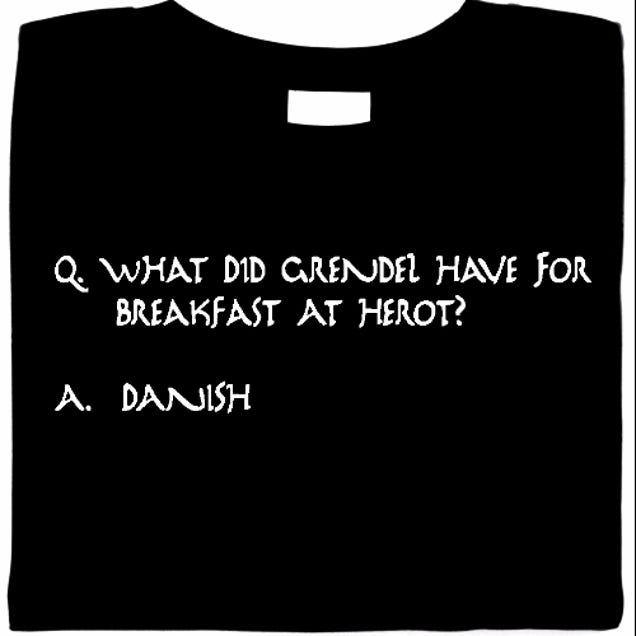 |
| Link |
To
read deeply and dynamically means, among other things, to embrace the exciting
fact that each new book defines its own terms and offers its own rules for
reading itself. A good man in Hamlet is different than a good man in The Importance of Being Ernest, for
example. Heroism in The Iliad is dynamically different that heroism in The Things They Carried. And so is the case with this complex,
mysterious poem. Our first job is that
we need to learn each book's own rules. What are the rules, the 'operating manual,' for Beowulf?
On
the first page of Beowulf, we know quite a bit. We know, for example, the poem’s
definition of a good king (god cyning),
one who has gifts in his hand for his kin and a bloody sword in his hand for
his enemy. We know that a person’s identity
is inextricably bound to the behavior of his lineage before him. No one is “his own man;” his identity, as a
result, is largely out of his control. We know the leader of the Danes - Hrothgar - embodies the kingly traits of warrior par
excellence and generous gift-giver as defined in the poem.
As
the pages continue and we learn of Hrothgar’s many successes, we learn about
the poem’s definition of a villain. We
meet Grendel and we are given a dynamic portrait of evil, the “good king”
flipped on its head.
Literally
speaking, Grendel is the monster that has decimated the Danes’ mead-hall and
gruesomely killed many of their best men.
Grendel only lives for about 20 pages (yet ravages the mead hall for
over a decade) but he is as interesting as any villain created in the last 100
years. He is not merely a “monster” as
he is often called in translation. He is
in Caines cynne (“in the line of Cain”
- l. 107) and is thereby genetically connected to the father of weapons,
murder, and fratricide. The Cain
connection is essential here, making Grendel the worst nightmare this poem can
conjure because kin-killing is in his DNA.
In this poem, warriors needed to utterly trust in the loyalty of their
fellow warriors and their kin.
Breakdowns in this system did not lead to a psychological insecurity but, rather, death itself. Grendel is also
an Ellen-gaest (86) or a
“powerful demon” or “powerful stranger.”
He moves like a villain and is called Earfothlice (86) – a prowler. He is Feonde on helle (100)–a fiend/enemy out of hell (a place as real to this poem's audience as Boston or New York is to us!). Grendel is Eotonas (112) – an Ogre, the Old Norse creature who was the giant, monstrous
undead, human but larger and cannibalistic.
He was preternaturally huge (gigantas
– l. 113) and, perhaps most disturbing of all was that he was an Orcneas (112), an evil phantom (from Old
Norse “ne” – corpse, eotenas “to eat” – hence “corpse eater”
– later reformed into Tolkien’s “orc”).
And the true sign of Grendel’s evil (as if corpse-eating wasn’t enough!)
is that Grendel lives out the most horrifying of Anglo-Saxon fates. He is alone, an An-gengea (165) – literally “one who goes alone” or “solitary one.” All of this information lives on a couple
pages in the poem and describes just one of the poem’s three key villains. We know his spiritual lineage and his
solitude, his size, his diet, and even how he moves, each of these details
adding another layer of evil to an already self-evident villain.
In
just a handful of manuscript pages, lines are being drawn. We know the poem’s standard for a good king
and also for the objective villain. At this
point, any rational reader would occasionally glance at the cover of the book
and wonder, where is the title character?
When
we finally meet Beowulf, we are not given the depth of information that we get
with the good king or the murderous monster.
In the first quarter of the
poem, we meet Beowulf, hear him speak persuasively and see him fight and behave
like a hero.
But unlike most narratives in which the hero has the
deepest backstory, Beowulf, who has the strength of 30 men in each arm, remains
a mystery. He tells heroic tales of his
youth that are uncorroborated. We know
his father’s name but he has no wife, no children, and his king has
mysteriously let him go on this strange search-and-destroy mission on behalf of
another people. Beowulf has no authority
and deep lineage (like King Hrothgar) and no nuanced personality and set of
traits (like Grendel).
Beowulf finally identifies himself to the Danish
coast guard when he bluntly states, “Beowulf
is min nama” (“Beowulf is my name”). I can’t help but to wonder that the poet had a clear understanding of
what made a good king and a convincing villain but perhaps didn't exactly know what to make of this Beowulf. Or maybe this is an early
example of the poet wanting the auidence to create its own definitions along the
way, to help shape the poem in the listening. The poet of the mead-hall was called the ‘shaper’ (scop) after all.
No comments:
Post a Comment